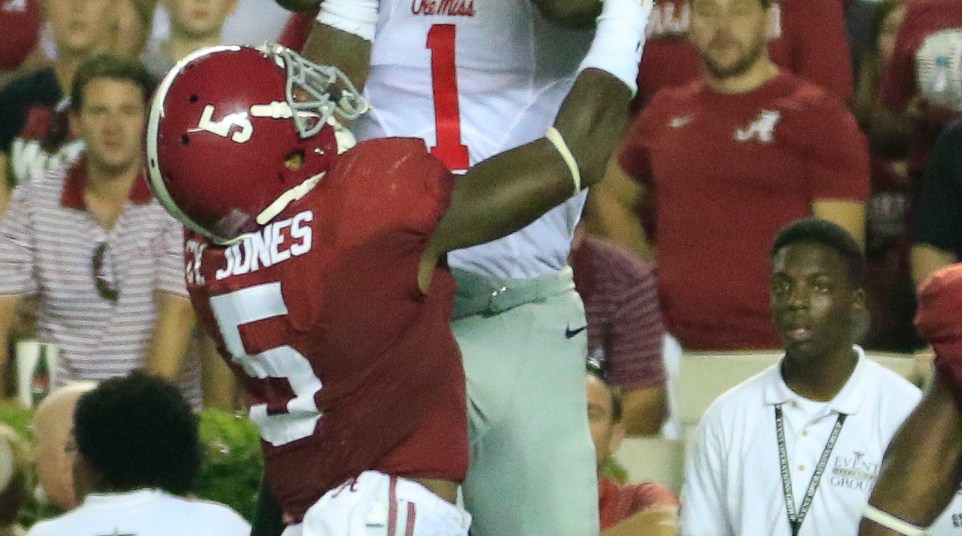
Ranking 10 best SEC wide receivers of 2015 season
Great receivers can’t go at it alone. Somebody has to throw them the damn ball.
And the latter half of that equation was a huge, defining problem throughout the SEC in 2015.
One of the worst years collectively for SEC QBs certainly helped explain why just one receiver cracked the 1,000-yard mark — the first time that’s happened since 2009.
Despite the challenges, 10 SEC receivers stood out in 2015.
10. Fred Ross, Mississippi State — Ross certainly benefitted from playing catch with Dak Prescott, but he led the SEC with 81 catches. He was third in yards (933). His teammate (spoiler alert) was a bigger big-play threat.
9. Drew Morgan, Arkansas — Certainly helped by the system and one of the SEC’s three best QBs, Morgan led the SEC with 10 TD receptions — on just 55 catches. That ratio alone tells you who Brandon Allen trusted when points were on the line.
8. Malachi Dupre, LSU — Probably the most frustrating aspect of LSU’s QB play this season was the fact it had weapons on the outside. Dupre averaged 15 yards per catch and was tied for sixth in the league with 6 TDs.
7. De’Runnya Wilson, Mississippi State — Ross caught more balls, but Wilson had a bigger impact. Both benefitted from playing with Prescott. Wilson finished second in the SEC with 9 TD catches.
6. Christian Kirk, Texas A&M — Texas A&M had QB issues too (obviously, given both transferred), but the Aggies still threw it 434 times — third-most in the SEC. So receivers are going to get theirs. Kirk certainly got his. He was fourth in the SEC in receptions (70) and yards (925) and tied for sixth with 6 TD catches. The one thing keeping him out of the top 5? His yards-per-catch was just 13.21 — 22nd in the SEC.
5. Antonio Callaway, Florida — Nowhere near as heralded as Kirk or Calvin Ridley — Rivals.com ranked Callaway the No. 36 receiver in the 2015 class — Callaway quickly emerged as the Gators’ big-play threat. Despite all of the QB turmoil in Gainesville, he led the SEC in yards-per-catch (20.10).
4. Travin Dural, LSU — Can you imagine Dural — 6-2, 202 with breakaway speed — in a pass-friendly offense with a capable QB? All he did this year was average 19.04 yards per catch — second in the SEC. Despite playing in just 10 games (injuries, weather cancellation), Dural shared the SEC lead with 2 catches for 50 or more yards. Not taking better advantage of Dural’s big-play ability (28 catches?) is one reason Tigers fans were so frustrated with the offense. Dural is a classic case of the skill set being better than the numbers suggest.
3. Pharoh Cooper, South Carolina — The only weapon the Gamecocks had. Opponents knew it, and still couldn’t stop him. He finished second in the SEC with 973 receiving yards tied for third with 8 TD receptions. His size — 5-11, 207 — is the big question as he moves closer to the NFL Draft.
2. Calvin Ridley, Alabama — It didn’t take Ridley long to trigger the Amari Cooper comparisons. Precise route-running, sure hands, toe-tapping on the sideline? Ridley showed that and more during a record-setting freshman season. He finished third in receptions (75), fifth in yards (893) and tied for ninth with 5 TD receptions.
1. Laquon Treadwell, Ole Miss — Watching Treadwell work with the league’s top quarterback, Chad Kelly, was a thing of beauty. The timing on one-on-one throws. The trust to throw into double coverage, believing he’d win a “34-66” ball. Treadwell has the measurable — 6-3, 220 — the numbers — SEC-best 1,082 yards, plus 8 TDs — but what really set him apart was this: He’s a football player. He showed time and again a willingness and ability to get involved in the run game, decleating several defensive backs with bone-jarring blocks.
As total packages go, nobody in the SEC came close to doing what he did this season.
